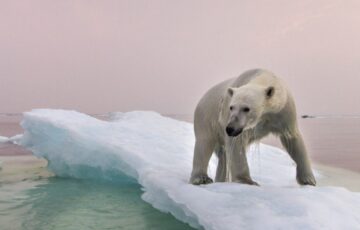Jaime Herndon at Undark:
 It’s an iconic image: A polar bear perched on a lone ice cap, drifting at sea. Is that the fate climate change has in store for this powerful Arctic inhabitant? In 2004, the discovery of a fossil polar bear jaw on Svalbard, a Norwegian archipelago, suggested another possibility. The fossil came from a bear that had lived between 110,000 and 130,000 years ago, an era that was warm — even warmer than today.
It’s an iconic image: A polar bear perched on a lone ice cap, drifting at sea. Is that the fate climate change has in store for this powerful Arctic inhabitant? In 2004, the discovery of a fossil polar bear jaw on Svalbard, a Norwegian archipelago, suggested another possibility. The fossil came from a bear that had lived between 110,000 and 130,000 years ago, an era that was warm — even warmer than today.
But studies of the genome extracted from the fossil showed the ancient bear had much greater genetic diversity than modern polar bears. Scientists hypothesized that when ice diminished in previous millennia, polar bears moved to land and interbred with brown bears, whose genes could have helped them adapt to the warmer weather. With possibly fewer genetic resources, today’s polar bears may not fare as well.
That’s one of the many unexpected discoveries covered in “Ends of the Earth: Journeys to the Polar Regions in Search of Life, the Cosmos, and Our Future,” the latest book by paleontologist and evolutionary biologist Neil Shubin. And the tenuous fate of the polar bear hints at the question at the heart of his narrative: What is it about the polar regions that seems so important to our understanding of the environment — and ourselves?
More here.
Enjoying the content on 3QD? Help keep us going by donating now.
